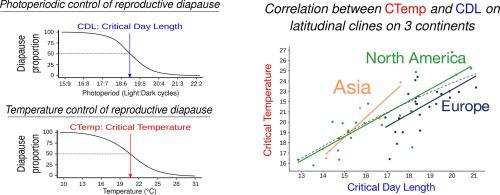Journal of Insect Physiology ( IF 2.3 ) Pub Date : 2023-08-19 , DOI: 10.1016/j.jinsphys.2023.104556 Pekka Lankinen 1 , Chedly Kastally 2 , Anneli Hoikkala 3

|
Insect adaptation to climatic conditions at different latitudes has required changes in life-history traits linked with survival and reproduction. Several species, including Drosophila montana, show robust latitudinal variation in the critical day length (CDL), below which more than half of the emerging females enter reproductive diapause at a given temperature. Here we used a novel approach to find out whether D. montana also shows latitudinal variation in the critical temperature (CTemp), above which the photoperiodic regulation of diapause is disturbed so that the females develop ovaries in daylengths that are far below their CDL. We estimated CTemp for 53 strains from different latitudes on 3 continents after measuring their diapause proportions at a range of temperatures in 12 h daylength (for 29 of the strains also in continuous darkness). In 12 h daylength, CTemp increased towards high latitudes alongside an increase in CDL, and in 3 high-latitude strains diapause proportion exceeded 50% in all temperatures. In continuous darkness, the diapause proportion was above 50% in the lowest temperature(s) in only 9 strains, all of which came from high latitudes. In the second part of the study, we measured changes in CTemp and CDL in a selection experiment favouring reproduction in short daylength (photoperiodic selection) and by exercising selection for females that reproduce in LD12:12 at low temperature (photoperiodic and temperature selection). In both experiments selection induced parallel changes in CDL and CTemp, confirming correlations seen between these traits along latitudinal clines. Overall, our findings suggest that selection towards strong photoperiodic diapause and long CDL at high latitudes has decreased the dependency of D. montana diapause on environmental temperature. Accordingly, the prevalence and timing of the diapause of D. montana is likely to be less vulnerable to climate warming in high- than low-latitude populations.
中文翻译:

蒙大拿州果蝇雌性生殖滞育的温度和光周期控制的临床变化
昆虫适应不同纬度的气候条件需要改变与生存和繁殖相关的生活史特征。包括蒙大拿果蝇在内的几个物种在临界日长(CDL)方面表现出强烈的纬度变化,低于该值,超过一半的新生雌性在给定温度下进入生殖滞育。在这里,我们使用了一种新颖的方法来查明蒙大拿石竹是否也表现出临界温度(CTemp)的纬度变化,高于该温度,滞育的光周期调节受到干扰,导致雌性在远低于其 CDL 的日照长度下发育卵巢。我们在 12 小时日照的一定温度范围内测量了来自 3 大洲不同纬度的 53 种菌株的滞育比例(其中 29 种菌株也在持续黑暗中),从而估计了它们的 CTemp。在12小时日照期间,CTemp随着CDL的增加而向高纬度增加,并且在3个高纬度品系中,在所有温度下滞育比例超过50%。在持续黑暗条件下,最低温度下滞育率超过50%的菌株只有9个,全部来自高纬度地区。在研究的第二部分中,我们在有利于短日照繁殖(光周期选择)的选择实验中测量了 CTemp 和 CDL 的变化,并通过对低温下 LD12:12 繁殖的雌性进行选择(光周期和温度选择)。在这两个实验中,选择引起了 CDL 和 CTemp 的平行变化,证实了这些性状沿纬度梯度之间的相关性。总体而言,我们的研究结果表明,高纬度地区对强光周期滞育和长 CDL 的选择降低了蒙大拿石竹滞育对环境温度的依赖性。因此,与低纬度种群相比,高纬度种群蒙大拿果蝇滞育的发生率和滞育时间可能更不易受到气候变暖的影响。





















































 京公网安备 11010802027423号
京公网安备 11010802027423号